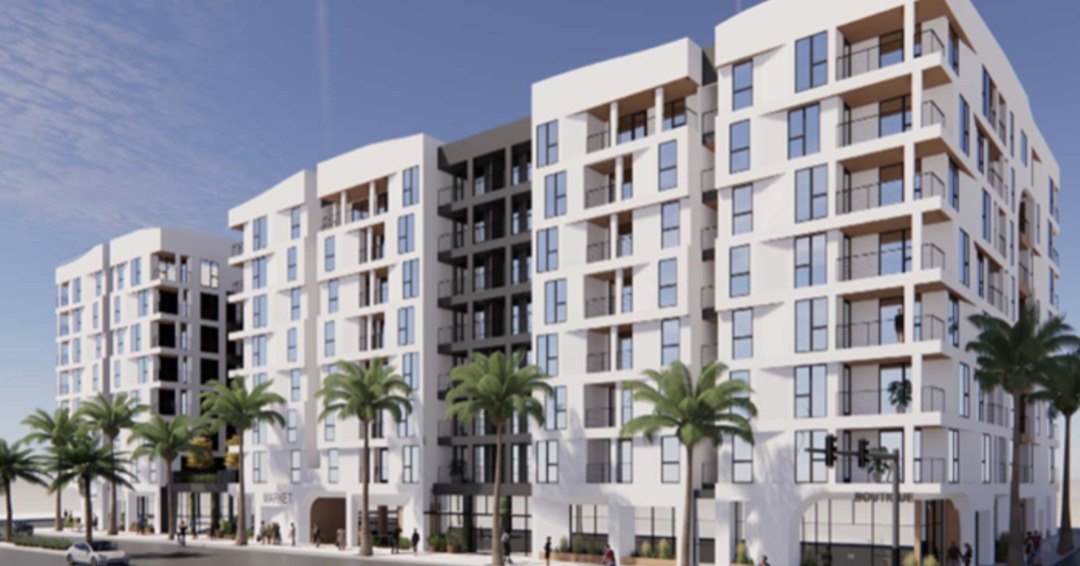
Attached below is our SMa.r.t. column from January 20, 2015, lightly edited for brevity but without loss of substance as it relates to today’s unfortunate evidence of prediction come true.
Northeast residents and neighbors, and all of the rest of us, will soon be funneled down the predicted dark corridors to the sea due to several new projects up to eight stories and 84 ft high. Be aware, however, that the 84 ft describes the roof height of the last floor but does not include the additional elevator, stair, and mechanical structures that can extend 18ft above the roof line and potentially cover more than 20% of the roof area, effectively creating a building 102 ft high.
Plan for 2501 Wilshire (above) 84 feet (or 102 Ft?)
Plan for 2025 Wilshire (above) 85 feet (or 103 ft?)
Plan for 1902 Wilshire
With heights up to 103 feet, it looks like even we at SMa.r.t. were off the mark in 2015 when we predicted dark tunnels of 6 or 7 stories…seems there are no limits to corporate welfare and State sponsored, dare I say, “land use terrorism.” Weak and ineffective, agenda-driven city councils for the past 15-20 years are as responsible for this vertical sprawl as are the State allowed bonuses, and I might mention that we got pushback from some council members about the column, that we were “crying wolf,” etc. Most of them are no longer on the council, though there are new acolytes who continually push the same agenda for more development, clearly having not learned that you will never build your way to affordability – but you will destroy resident livability and harm the environment if this unfettered over development continues.
Our edited column from 20 January 2015:
Our Boulevards- Dark Tunnels or Sunlit Paths to the Sea?
“Cities are entered and organized around their major boulevards. The 9 boulevard entrances to our City are San Vicente, Wilshire, Santa Monica, Broadway, Colorado, Olympic, Pico, Ocean Park, and Lincoln. Along our boulevards are over 900 buildings…
If 1/3 of these buildings were to remain as is or be developed through adaptive reuse with tax incentives, the remaining 525 buildings could be redeveloped as 3 or 4-story buildings. If so, these new projects could provide 15 million sq. ft. of additional leasable area while still leaving 30% open space. Is our City’s appetite for growth so great that this would not satisfy our needs for the near future?
The following sketches provide markedly different visions for the future of the Boulevards and our City. Will Santa Monica become an extension of Los Angeles, or will it retain its small beach town character?
Fig. 1. Wilshire Blvd. at the Santa Monica boundary (primarily 1 to 2 stories)
The current alternative approach allows doubling building heights to 6 or 7 stories, concentrating development into fewer structures and creating a cityscape more akin to West Los Angles than Santa Monica. Shadows will cover the E-W Boulevards for a large part of the day, and these structures would be adjacent to neighboring homes resulting in significant negative impact on their livability. The new California codes regulate shading of adjacent properties and need to be enforced.
Fig. 2. Allowable increase in height (6 to 7 stories).
Re-developing to 3 or 4 stories could more than double the current square footage, a substantial increase without impacting the City’s low-scale skyline. Another advantage is the City’s density could be spread over larger areas and time frames, minimizing the impact of density and vehicles in any single location. This would allow the City to grow at a moderate pace and impact residents less while maintaining the City’s small-town allure.
Fig. 3. Alternative increase in height and stepped facades (3 to 4 stories)
The other advantage is that it would preserve some of our historic building stock, providing continuity with the past and preserving the unique character of our City for the future. And our Zoning code needs to encourage adaptive reuse of existing 1 & 2-story buildings – especially on narrow lots that don’t permit 3 & 4-story redevelopment. The retention of 1 and 2-story buildings might also provide additional workforce housing.
If not, we won’t know what we’re losing until it’s gone. The LUCE has a clearly stated goal of “Overall Height Reduction.” A simple 30-40-50 ft. code would provide clarity for developers as well as protect residents with an iron-clad cap on building heights. We need to close the Development Agreement (D.A. ) loophole that allows developers to exceed height limits through the provision of “Community Benefits.” These D.A.’s are one of the biggest causes of community distrust. The trade-off of community benefits for increased density, height, traffic, and parking, along with increasing land values resulting in higher rents and loss of local business, is not an exchange that serves our community…
Ron Goldman, Thane Roberts, and Robert Taylor for SMa.r.t. (Santa Monica Architects for a Responsible Tomorrow)”
So the warning was there, yet the Council and Planning Commission over the years failed to stand up and act in the best interests of the residents, the residents to be, and the environment, with a repeated ‘justification’ that there was a “housing crisis.” Well, there was, and is, an affordability crisis, exacerbated now by the excessive permitted development that, much like the incredibly massive Gelson’s proposal at Lincoln and Ocean Park Blvd. of 521 units, provides only 10% “affordable” units. So too, are the proposed Wilshire Blvd. projects by the same developer, providing 90% market rate housing with what appears to be only 10% identified as affordable.
You were warned.
SMa.r.t.
Santa Monica Architects for a Responsible Tomorrow
Ron Goldman, Architect FAIA; Bob Taylor, Architect AIA; Dan Jansenson, Architect, Building & Fire-Life Safety Commissioner; Thane Roberts, Architect; Mario Fonda-Bonardi, Architect AIA, (Ex-Planning Commissioner); Sam Tolkin, Architect, Planning Commissioner; Michael Jolly, ARE/CRE
For previous articles, see www.santamonicaarch.wordpress.com/writing













